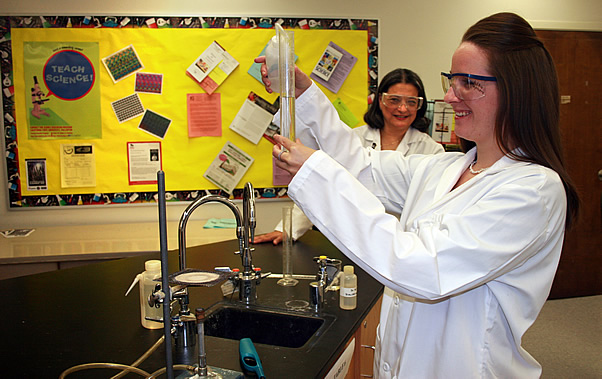Campus Receives Nearly $900,000 in Stimulus Funds
Grant to Support Future Secondary Chemistry, Biology Teachers
September 15, 2009
By Debra Cano Ramos
Liz Michicoff’s high school teacher made chemistry fun and exciting. Now as a senior chemistry major at Cal State Fullerton, she wants to be that teacher who inspires students to want to learn about science.
Michicoff and other science majors will be able to pursue a career teaching chemistry and biology with the help of $899,998 in funding awarded to Cal State Fullerton from the American Recovery and Reinvestment Act.
The funding, administered by the National Science Foundation under its Robert Noyce Teacher Scholarship Program, will be used to establish “Teaching as a Primary Profession in Biology and Biochemistry.” The program’s goal is to increase the number of middle and high school chemistry and biology teachers.
“TAPP will encourage talented biology and biochemistry undergraduates to become highly qualified secondary teachers of both biology and chemistry,” said Barbara L. Gonzalez, associate professor of chemistry and biochemistry who is overseeing the new program.
Over the next four years, the funding will provide 50 scholarships with each recipient receiving $10,000 annually for up to three years.
Cal State Fullerton’s colleges of Natural Sciences and Mathematics, and Education will collaborate with Anaheim Union High School District, Mt. San Antonio College and University of California, Los Angeles, to implement the program.
Co-advisers of the TAPP program are Victoria B. Costa, director of science education and professor of secondary education; Chandra Srinivasan, associate professor of chemistry and biochemistry; and Marcelo E. Tolmasky, professor of biological science.
The program is designed to enrich students’ understanding of biochemistry and biology, provide opportunities to conduct research in Cal State Fullerton laboratories, tutor science in CSUF and secondary schools, develop effective pedagogical skills, and provide early field experiences in secondary classrooms.
Cultivating Science Teachers
Applications for scholarships will be available this fall to those who have earned a bachelor of science degree and plan to apply for the credential program for entry in spring 2010. In spring 2010, applications will be available for undergraduates who will make an early commitment to teaching for support to complete their B.S. degree, Gonzalez said. This funding is renewable through the degree and credential program, contingent on the student's progress and commitment to teaching, she added.
“TAPP candidates will be selected for academic merit with the hope that their involvement in activities rich in scientific inquire will nurture their passion to learn and to teach biology and chemistry,” added Gonzalez, who specializes in chemical education research.
Students selected for TAPP scholarships also would receive a laptop computer to use in preparing classroom lessons, a stipend to travel to a science education meeting and funds to pay for research supplies, Costa said.
“The grant offers a large financial incentive for students to become credentialed in two science areas,” Costa noted. “This is great for students’ marketability as teachers because schools often need a teacher to teach in more than one content area.”
Better preparing credential students about content standards and pedagogy involved in teaching biology and chemistry gives them increased competence to teach about the integration of science research between the disciplines, Costa explained.
“Teachers who are credentialed in multiple areas are able to help their students see the complexity of our natural world,” she said.
“The scholarship would help me so I can concentrate more on getting my credential and not having to worry about how I balance my time between work, school and life,” said Michicoff, who also plans to pursue a master’s degree in chemistry with an emphasis in education. She is performing chemical education research under Gonzalez’s guidance.
Partnering with Anaheim Union High School District and other higher education institutions will help to boost recruitment efforts for the program and get students to make a commitment to a career in teaching.
“We want students to view teaching as a primary profession,” Gonzalez said. “We also want students to know that by becoming a chemistry and biology teacher, they can make an impact in our society to prepare the next generation for an increasingly technological and global environment.”
Science Teacher Shortage
Fewer students are studying and pursuing careers in the science, technology, mathematics and engineering fields, according to the National Center for Educational Statistics.
In Orange County alone, secondary schools are in great need of qualified science teachers, said Gonzalez,who noted that Cal State Fullerton — one of the largest secondary credential programs in Orange County — produced only two chemistry and 12 biology credential candidates in 2008.
“This fall shorts of the demand for science teachers in the area, especially in diverse, low-performing, high-need schools,” she said. “As a result, a large number of high school chemistry classes are taught by teachers who majored in biology.”
Costa added that through TAPP, “we want to improve the physical science content knowledge and pedagogical skills of our teacher candidates so that we are preparing highly qualified, exemplary teachers in all of the science disciplines.”


